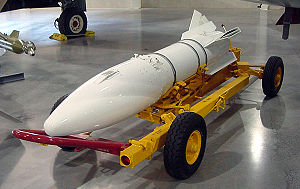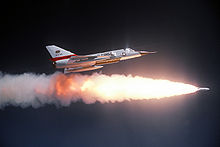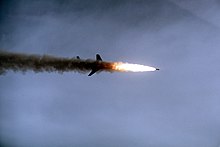This is an old revision of this page, as edited by Rwendland (talk | contribs) at 11:46, 22 October 2015 (wikilink). The present address (URL) is a permanent link to this revision, which may differ significantly from the current revision.
Revision as of 11:46, 22 October 2015 by Rwendland (talk | contribs) (wikilink)(diff) ← Previous revision | Latest revision (diff) | Newer revision → (diff)Short-range air-to-air missile
| AIR-2 Genie | |
|---|---|
 AIR-2A Genie nuclear air-to-air rocket on a MF-9 Transport Trailer at Hill Aerospace Museum AIR-2A Genie nuclear air-to-air rocket on a MF-9 Transport Trailer at Hill Aerospace Museum | |
| Type | Short-range air-to-air missile |
| Place of origin | United States |
| Service history | |
| In service | 1958–85 |
| Production history | |
| Manufacturer | Douglas Aircraft Company |
| Produced | 1957–62 |
| Specifications | |
| Mass | 822 pounds (372.9 kg) |
| Length | 9 feet 8 inches (2.95 m) |
| Diameter | 17.5 in (444.5 mm) |
| Wingspan | 3 ft .4 in (0.9 m) |
| Warhead | 1.5-kT nuclear |
| Engine | Thiokol SR49 |
| Propellant | Solid fuel |
| Operational range | 6 miles (9.7 km) |
| Maximum speed | Mach 3.3 |
The Douglas AIR-2 Genie (previous designation MB-1) was an unguided air-to-air rocket with a 1.5 kt W25 nuclear warhead. It was deployed by the United States Air Force (USAF 1957–1985) and Canada (Royal Canadian Air Force 1965–68, Air Command 1968–84) during the Cold War. Production ended in 1962 after over 3000 were made, with some related training and test derivatives being produced later.
Development


The interception of Soviet strategic bombers was a major military preoccupation of the late 1940s and 1950s. The revelation in 1947 that the Soviet Union had produced a reverse-engineered copy of the Boeing B-29 Superfortress, the Tupolev Tu-4 (NATO reporting name "Bull"), which could reach the continental United States in a one-way attack, followed by the Soviets developing their own atomic bomb in 1949, produced considerable anxiety.
The World War II-vintage fighter armament of machine guns and cannon were inadequate to stop attacks by massed formations of high-speed bombers. Firing large volleys of unguided rockets into bomber formations was not much better, and true air-to-air missiles were in their infancy. In 1954 Douglas Aircraft began a program to investigate the possibility of a nuclear-armed air-to-air weapon. To ensure simplicity and reliability, the weapon would be unguided since the large blast radius made precise accuracy unnecessary.
The resultant weapon carried a 1.5-kiloton W25 nuclear warhead and was powered by a Thiokol SR49-TC-1 solid-fuel rocket engine of 162 kN (36,500 lbf) thrust. It had a range of slightly under 10 km (6.2 mi). Targeting, arming, and firing of the weapon were coordinated by the launch aircraft's fire-control system. Detonation was by time-delay fuze, although the fuzing mechanism would not arm the warhead until engine burn-out, to give the launch aircraft sufficient time to turn and escape. Lethal radius of the blast was estimated to be about 300 meters (1,000 ft).
The first test firings of inert rounds took place in 1956, and the weapon entered service with the designation MB-1 in 1957. The popular name was Genie, but it was often nicknamed "Ding-Dong". About 3,150 rounds were produced before production ended in 1963. In 1962 the weapon was redesignated AIR-2A Genie. Many rounds were upgraded with improved, longer-duration rocket motors, the upgraded weapons sometimes known (apparently only semi-officially) as AIR-2B. An inert training round, originally MB-1-T and later ATR-2A, was also produced in small numbers.

A live Genie was detonated only once, in Operation Plumbbob on 19 July 1957. It was fired by AF Captain Eric William Hutchison (pilot) and AF Captain Alfred C. Barbee (radar operator) flying an F-89J over Yucca Flats. Sources vary as to the height of the blast, but it was between 18,500 and 20,000 ft above mean sea level. A group of five USAF officers volunteered to stand hatless in their light summer uniforms underneath the blast to prove that the weapon was safe for use over populated areas. They were photographed by Department of Defense photographer George Yoshitake who stood there with them. Gamma and neutron doses received by observers on the ground were negligible. Doses received by aircrew were highest for the fliers assigned to penetrate the airburst cloud ten minutes after explosion.

The Genie was cleared to be carried on the F-89 Scorpion, F-101B Voodoo, F-106 Delta Dart, and F-104 Starfighter in U.S. service. A trapeze launcher was fitted beneath a Starfighter, but it was never carried in operational service. Convair offered an upgrade of the F-102 Delta Dagger that would have been Genie-capable, but it was not adopted. Operational use of the Genie was discontinued in 1988 with the retirement of the F-106 interceptor.
The only other user was Canada, whose CF-101 Voodoos carried Genies until 1984 via a dual-key arrangement where the missiles were kept under United States custody, and released to Canada under circumstances requiring their use. The RAF briefly considered the missile for use on the English Electric Lightning.
Safety features included final arming by detecting the acceleration and deceleration of a fast aircraft at high altitude. The weapon was built too early to use a permissive action link security device.
The F-89J that was used to launch the only live test is on static display at the Montana Air National Guard in Great Falls, Montana.
Operators
- Royal Canadian Air Force /Canadian Forces Air Command (Discontinued)
Specifications (AIR-2A)

- Length: 2.95 m (9 ft 8 in)
- Diameter: 0.44 m (17.5 in)
- Wingspan: 1.02 m (3 ft 4 in)
- Launch weight: 373 kg (c lb)
- Speed: Mach 3.3
- Range: 9.6 km (6 mi)
- Guidance: Inertial (None)
- Warhead: W25 nuclear fission, 1.5 kiloton yield
- Date deployed: 1957
- Date retired: 1985
Used with MF-9 Transport Trailer
Survivors
| This section needs expansion. You can help by making an edit requestadding to it . (June 2008) |
Below is a list of museums which have a Genie rocket in their collection:
- Air Force Armament Museum, Eglin Air Force Base, Florida
- Atlantic Canada Aviation Museum, Halifax, Nova Scotia
- Hill Aerospace Museum, Ogden, Utah
- MAPS Air Museum, Akron-Canton Regional Airport, Ohio ATR-2 with MF-9 trailer
- Museum of Aviation at Robins Air Force Base, Georgia ATR-2N with MF-9 trailer
- National Museum of the United States Air Force, Wright-Patterson Air Force Base, Ohio
- Oregon Military Museum at Camp Withycombe, Clackamas, Oregon
- Pima Air & Space Museum, Tucson, Arizona Inert round with trailer
- Selfridge Air National Guard Base Museum, Harrison Township, Michigan
- Western Canada Aviation Museum, Winnipeg, Manitoba, Canada
- Ellsworth Air and Space Museum at Ellsworth Air Force Base, Rapid City, South Dakota
- Air Defence Museum, CFB Bagotville, 3rd Wing, Saguenay, Quebec, Canada
- Comox Air Force Museum, CFB Comox, 19 Wing, Comox, British Columbia, British Columbia, Canada
- Vermont National Guard Library and Museum, Camp Johnson, Colchester, Vermont
- Jimmy Doolittle Air & Space Museum, Travis Air Force Base, California
- National Atomic Testing Museum, Paradise, Nevada
- Malmstrom Air Force Base Museum, Great Falls, Montana
See also
References
- http://www.boeing.com/history/mdc/genie.html
- ^ John Clearwater (1998), Canadian Nuclear Weapons: The Untold Story of Canada's Cold War Arsenal, Dundurn Press Ltd, ISBN 1-55002-299-7, retrieved 10 November 2008
- SHOTS DIABLO TO FRANKLIN PRIME The Mid-Series Tests of the PLUMBBOB Series 15 JULY - 30 AUGUST 1957
- "Five at Ground Zero". CTBTO. 19 July 1957. Retrieved 17 February 2014.
- Defense Threat Reduction Agency. Public Affairs. Factsheet. Operation Plumbbob.
- Attachment 12. Preliminary report. Operation Plumbbob. Nevada Test Site, May-September 1957. Project 2.9 NUCLEAR RADIATION RECEIVED BY AIRCREWS FIRING THE MB-1 ROCKET.
- Museum of Aviation Website
- "McDonnell Douglas Air-2A Genie Rocket." National Museum of the United States Air Force. Retrieved: 9 August 2015.
| 1963 United States tri-service rocket designations and post-1963 undesignated rockets | |
|---|---|
| Designated (1–) | |
| Undesignated | |
| 1955–1962 United States Air Force rocket and missile designations | |||||
|---|---|---|---|---|---|
| Air-to-air missiles |
| ||||
| Other types | |||||
| Undesignated types | |||||